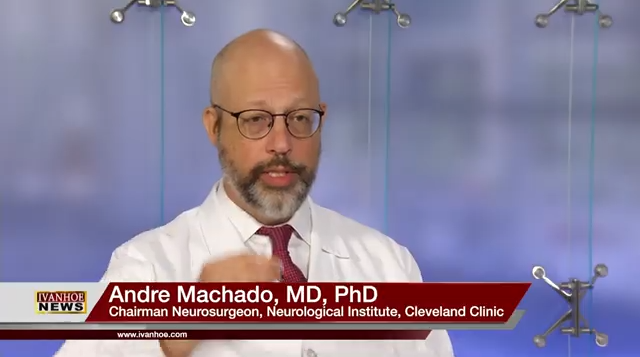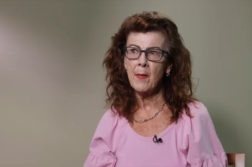Dr. Andre Machado, Chairman Neurosurgeon of the Neurological Institute at the Cleveland Clinic, talks about a treatment for Parkinson’s disease that can be used for stroke survivors who have suffered paralysis.
Interview conducted by Ivanhoe Broadcast News in 2023.
Do you see a lot of stroke survivors with paralysis?
Machado: Yes.
And there’s not a lot of help other than physical therapy after a stroke happens, right?
Machado: So rehabilitation today is the treatment for the post-stroke stages. Rehabilitation works very well. It provides a ton of improvement after a stroke. It is important for people to have access to rehabilitation, but it also has limitations. About half of the patients that suffer a stroke despite best efforts with physical therapy, occupational therapy continue to be disabled to the point that they need assistance of another person for their daily activities.
But DBS has been around for a little bit, and it has made a lot of impact on the stroke world, right?
Machado: Not yet. So the DBS is today a treatment for Parkinson’s disease. It’s also used under more restricted conditions for a problem called dystonia, it’s a movement problem, and some forms of epilepsy and obsessive-compulsive disorder. The work that we have done is the first use of deep brain stimulation for stroke rehabilitation.
How does it work? How do you do it?
Machado: What we typically do in patients with Parkinson’s disease is an intervention of placing a wire in the brain that connects to a pacemaker-type device. You can think of it as a brain pacemaker. And the intent is to reduce an abnormal movement that is happening on top of the normal movement. So the person can move, but that movement is affected by a tremor, for example, that changes the quality of the movement and what you can do. And treatment for…
Stroke?
Machado: No. The use of deep brain stimulation for tremor is aimed at reducing the tremor to allow the normal movement that’s under the tremor to come through. In stroke, very different situation. There is no movement to begin. It’s not that there is an abnormal movement upon the normal movement, there’s no movement. So we had to modify the use of the technology after years of work in the laboratory to test it for the first time in patients that had suffered a stroke to see how much improvement we could get in their hands.
Is that modifying it and the placement of the brain?
Machado: The modification was in where it goes in the brain, very different location.
Where?
Machado: In Parkinson’s disease typically we go from the top of the brain and then into the depth of the brain from there. For a stroke, the work was done actually from the back of the brain in a part of the brain called the cerebellum. And we went into the depth of that part of the brain because it connects with the areas of the cerebral cortex that are involved in the recovery from stroke. And through that connectivity, we were able to apply this stimulation and we saw the benefits.
What did you see in your study?
Machado: First of all, this is the first time that it’s done in patients. It’s the first in human study. And the work that we had done before was all in laboratory. The primary objective here was to learn that it’s safe and that it can be done. And in the 12 patients it was safe and it could be done. We completed this study successfully. Then we learned that there were improvements that were beyond what one would typically expect out of physical therapy and occupational therapy alone. We saw patients with some very robust improvements that gained the function of their hand to a point that it’s useful.
How long was the DBS in the person?
Machado: Patients participated in the study for over one year. And the first thing that we did after replacing DBS and allowing them to recover from the surgery was physical therapy without turning on the DBS. We wanted to see how much they could improve with the physical therapy alone, with the occupational therapy alone. And then we turned on the DBS to see if we could see an improvement beyond that. And we saw significant benefits between 4-8 months after turning on the DBS, they continued to improve. And then we turned off the DBS to see if they would lose any of the benefits and they didn’t.
How have they kept their movement a year out?
Machado: They did. We have now completed the study. And after turning off the DBS and actually after taking it out, whatever they gained remained.
I know for Stan Shipkosky, it was life-changing because he could not open his hand and now he was just showing us. He has good hand movement.
Machado: It’s often the case that someone with a severe stroke can do a little bit of a grip. The difficult part is to be able to open the hand. And for us to use our hands, we can not only grip, releasing is very important. And that is very much what we were trying to achieve with the use of this new technology.
Do you remember that moment when your first patient came in and you turned it on and they were able to move? Was it a learning curve or were they automatically able?
Machado: No, the effect is not acute. It’s not that we turned it on and they move their hand. It’s that we kept it on after very careful adjustment here, there’s a science to the adjustment and combined it with months of physical therapy. And what we observed is that they were able to improve in physical therapy beyond what they had been able to improve with physical therapy prior to the study. So it was a continuous process.
Do you feel that this could be an answer for so many people?
Machado: There are millions of Americans that are stroke survivors and live with these impairments. That is our work. Our whole team is working to develop this technology for patients that are currently disabled and cannot use their hands. And our whole objective is to give them a new function.
What’s next for this?
Machado: Next for this is a randomized controlled trial. Meaning we’re going to enroll a number of patients. We’re already enrolling a number of patients. And after having the DBS implanted in the brain, there will be, so to speak, the flip of a coin, a randomization, and patients will be randomly placed on having the DBS on or having the DBS sham on, but not really effective. Then they are going to go through the same rehabilitation, the same physical therapy so that we can compare head to head what happens with physical therapy when the DBS is on versus when it’s sham.
Did all 12 patients improve?
Machado: No. I’ll rephrase that. All 12 patients improved. Nine improved to a point that it’s considered meaningful. There’s a cut-off that one can say that that improvement is meaningful, you can now do something you couldn’t do before.
Now putting the DBS in, you say into the brain, is it minimally invasive? Invasive? Is it risky?
Machado: This is invasive. This is, this is brain surgery. It is experimental brain surgery that these participants Stan went through. And we owe them enormous gratitude for their trust in participating in this study that had never been done in patients before. They were there because they wanted to improve themselves. But most patients, like Stan told us that they were there also to contribute to science, that they wanted this to help someone else afterwards.
Are there stroke patients that would not be a good candidate?
Machado: Yes. We have learned through this study that patients that have a little bit of functional leftover in their hand, even if it’s just a little, they do much better than those that are completely paralyzed and have absolutely no ability to move their hand. Now, in the next study, we already narrowed down the inclusion criteria, the patients that we’re going to accept into the study, to those that actually have a little bit of movement left because we know that it will improve more.
When will this study start?
Machado: It already did.
Oh, it already has. And it’s still enrolling patients?
Machado: It’s still enrolling patients. It’s an active study approved by the Food and Drug Administration and by the IRB of the Cleveland Clinic. It’s an actively enrolling study.
How many patients are you enrolling?
Machado: The total study is going to have up to 40 patients. It’s going to have more sites. It’s going to include the other hospitals. Right now, it’s only enrolling at Cleveland Clinic.
Anything I’m missing?
Machado: This is a treatment for patients that survive the stroke and remain disabled for a stroke. That’s what these researchers about. A lot happens in the minutes after a stroke. So if someone has symptoms of stroke, it’s important to get to a hospital fast. Time is brain, and more important than treating it first is prevention. Can smoke all the things that you hear from your doctor that will protect the heart from heart disease, will also protect the brain from stroke.
Interviewer: Perfect. Stan was killing me. He was telling me about his story and he was like, I passed on my living room floor and I got up and I went and made dinner and then I passed on the kitchen floor and I felt really tired, so I just went to sleep. And he woke up the next morning when a neighbor came. And I was like, oh my God, you did so much wrong. I did not say that to him.
END OF INTERVIEW
This information is intended for additional research purposes only. It is not to be used as a prescription or advice from Ivanhoe Broadcast News, Inc. or any medical professional interviewed. Ivanhoe Broadcast News, Inc. assumes no responsibility for the depth or accuracy of physician statements. Procedures or medicines apply to different people and medical factors; always consult your physician on medical matters.
If you would like more information, please contact:
Halle Bishop Weston
Sign up for a free weekly e-mail on Medical Breakthroughs called First to Know by clicking here




